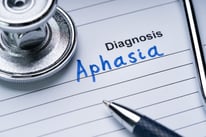There are an estimated one million Americans who are living with a condition known as aphasia. Here is an overview of what aphasia is, the types, and therapies used.
What Is Aphasia?
Aphasia is a language disorder that affects a person's ability to communicate. This disorder is often the result of brain damage due to a stroke. Aphasia can also be the result of a head injury or the gradual growth of a brain tumor as well as a disease causing permanent, progressive damage. People with aphasia may be limited in more than one communication area. A person with aphasia can have trouble speaking, reading, writing, and understanding language.
Types of Aphasia 
There are several types of Aphasia, such as Broca’s, Wernicke’s, Primary Progressive, Anomic, Mixed Non-fluent and Global. Aphasia conditions range from mild to severe. Here’s an overview of types of Aphasia.
Broca's Aphasia (Expressive or Non-fluent)
People with Broca's aphasia know what they want to say but have a hard time communicating their thoughts in words or sentences. It's caused from damage to the Broca's part of the brain, which is on the left side of the frontal lobe.
A person with Broca’s aphasia may understand speech relatively well and be able to read but be limited in writing.
Wernicke's Aphasia (Fluent Aphasia)
Wernicke also known as fluent aphasia or receptive aphasia. Wernicke’s aphasia results from damage to Wernicke’s area of the brain. This type of aphasia involves someone have difficulty in understanding spoken and written language. Speech is characterized by fluent speech that does not make sense.
Mixed non-fluent aphasia
People with this type of aphasia resemble those with severe Broca's aphasia as they have minimal speaking ability. But unlike those who have Broca's aphasia, they’re limited in their comprehension of speech and do not read or write beyond an elementary level.
Anomic aphasia
This form of aphasia involves someone having difficulty finding the right words when they speak or write. It's generally the result of damage to the language area of the brain due to stroke or trauma.
Primary progressive aphasia
Primary Progressive aphasia is rare neurological syndrome. This condition is a degenerative brain condition. It results from deterioration of brain tissue affecting areas of the brain that are important for speech and language.
Global aphasia
This type is the most severe form of aphasia. A person with Global Aphasia can neither read nor write. This may often be seen immediately after a person has suffered a stroke.
Therapies Used in Treating Aphasia
The two basic categories of therapies used by most clinicians in treating aphasia include impairment-based therapies and communication-based therapies.
- Impairment-based therapies—These are therapies that are designed with a focus on improving language functions. They involve a clinician using procedures that stimulate specific speaking and listening, besides improving reading and writing skills. Computer software using word-finding exercises and how to solve real-life problems, such as how to exchange money, is a common treatment.
- Communication-based therapies—Also known as consequence-based therapies, these are therapies aimed at improving communication by whatever means. What's more, they encourage caregiver support. Usually, they entail interactions that involve common challenges in real life communications.
Treatments for Aphasia
- Individualized care plans—Speech-language pathologists customize the plan of care to each aphasia patient. While some people need help in finding the right words, others need help with word comprehension.
- Language action therapy—This therapy emphasizes verbalizing words. Besides having the person sound out words, the clinician helps the person use the words in short sentences.
- Technology apps for aphasia—Clinicians use apps and computer programs designed to enhance speech-language therapy for their patients. There are also some tablet and telephone apps that include aphasia exercises that help patients practice saying words
- Supported conversation—Family members are taught to use close-ended questions when communicating with loved ones with aphasia. Moreover, caregivers are taught the importance of giving people with aphasia time to speak.
How Caregivers Can Help Loved Ones with Aphasia
- Before you begin to talk, be sure you the person has your attention.
- Reduce the amount of background noise when talking to a person with aphasia. For example, turn off the radio or TV.
- Ask simple questions that can be answered with "yes" or "no".
- Don't shout but speak normally, unless the individual tells you otherwise.
- Use gestures and drawings.
- State your topic before you start a conversation.
- Don't make your conversations too lengthy or complex.
- Remember that people with aphasia need time to say what they want to say or use non verbal
Each person’s experience with aphasia is unique. Aphasia can improve with time and therapy.
Questions? To learn more about how we can help you in caring for a loved one please contact us.

